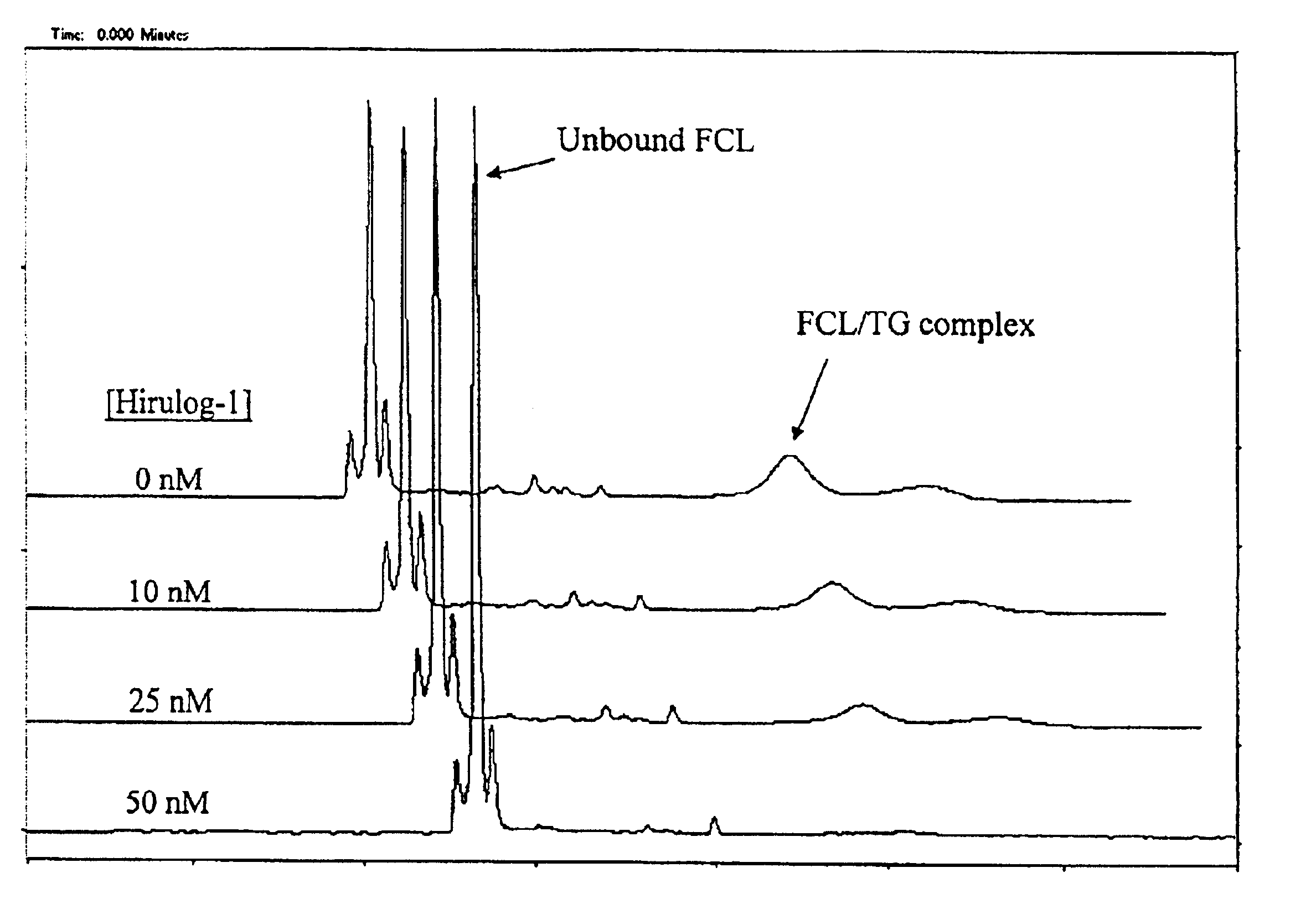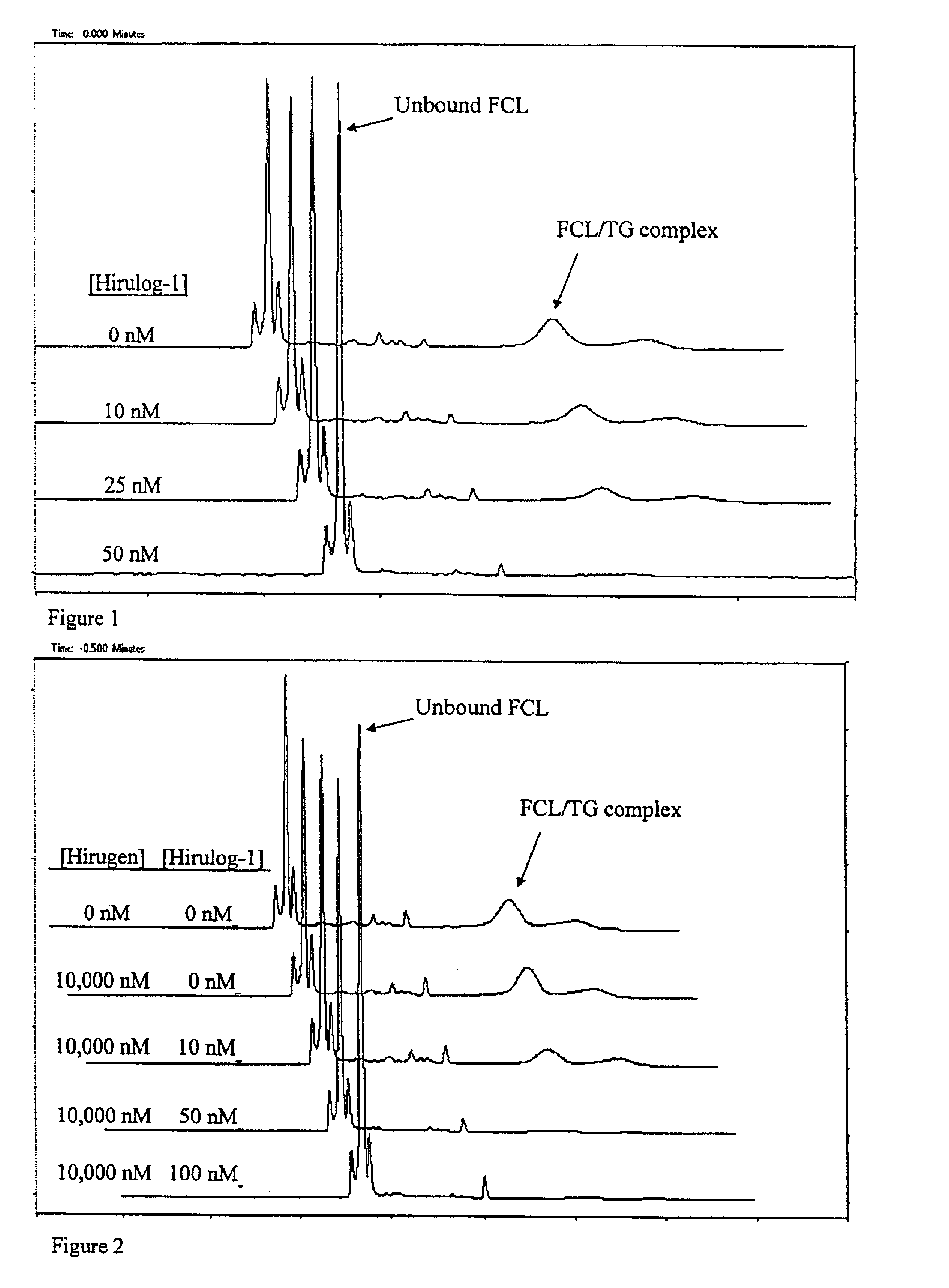Capillary electrophoresis method for screening for affinity ligands using a detectable competitive ligand
a competitive ligand and affinity ligand technology, applied in the direction of fluid pressure measurement, liquid/fluent solid measurement, peptide, etc., can solve the problems of unique and difficult challenges of biologically active compounds
- Summary
- Abstract
- Description
- Claims
- Application Information
AI Technical Summary
Benefits of technology
Problems solved by technology
Method used
Image
Examples
example 1
FIG. 1 demonstrates an experiment where 50 nM of a target, the anticoagulant protein, thrombin (TG), is first incubated, prior to CE, for 5 minutes with different concentrations of a test candidate ligand: the tight-binding synthetic ligand, hirulog-1 (D-Phe-Pro-Arg-Pro-(Gly)4-Asn-Gly-Asp-Phe-Glu-Glu-Ile-Pro-Glu-Glu-Tyr-Leu; Kd˜2×10−9M). Also prepared is 100 nM of a fluorescently labeled, tight-binding competitive ligand, single-stranded (ss) DNA oligonucleotide 5′-fluorescein-GGTTGGTGTGGTTGG-3′ (Kd=3×10−9 M; hereinafter “FCL”). The mixture of target and candidate ligand (TG / LG) is first injected into the CE instrument for about ten (10) seconds to give a first plug, followed by a 10-second injection of FCL as the second plug.
Voltage of about 20 kV is applied to initiate electrophoresis, and the unbound competitive ligand (FCL) and bound FCL / TG complex peaks are monitored during CE by means of laser-induced fluorescence and a fluorescence detector positioned at a detection point alo...
example 2
FIG. 2 demonstrates an experiment where a tight-binding, test candidate ligand, hirulog-1, is detected even in the presence of high concentrations of a weak-binding test candidate ligand, hirugen (Gly-54-Leu-65 carboxyterminal dodecapeptide of hirudin with sulfated tyrosine; Kd=1.5×10−7 M). Here the thrombin target (TG) is incubated, prior to CE, for five minutes with samples containing hirugen and hirulog-1 at different concentrations. Each of these target / sample mixtures is subjected to a CE screening run, as follows. A plug of target / sample mixture is pressure-injected into the CE instrument for 10 seconds to give a first-injected plug. A second injection plug of 100 nM FCL is then injected for 10 seconds, and then voltage of about 20 kV is applied to start electrophoresis. The CE migration of the FCL and FCL / TG complex are monitored by way of laser-induced fluorescence. Again, the FCL has a higher electrophoretic mobility than the TG, so that the unbound FCL peak appears before ...
PUM
| Property | Measurement | Unit |
|---|---|---|
| Temperature | aaaaa | aaaaa |
| Temperature | aaaaa | aaaaa |
| Fraction | aaaaa | aaaaa |
Abstract
Description
Claims
Application Information
 Login to View More
Login to View More - R&D
- Intellectual Property
- Life Sciences
- Materials
- Tech Scout
- Unparalleled Data Quality
- Higher Quality Content
- 60% Fewer Hallucinations
Browse by: Latest US Patents, China's latest patents, Technical Efficacy Thesaurus, Application Domain, Technology Topic, Popular Technical Reports.
© 2025 PatSnap. All rights reserved.Legal|Privacy policy|Modern Slavery Act Transparency Statement|Sitemap|About US| Contact US: help@patsnap.com


